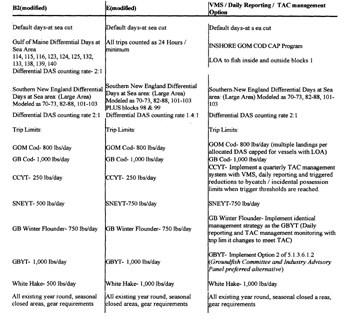
The chart above contains the details of the three options that were on the table. B2 (modified)-Council Plan Development Team Alternative; E (modified), and VMS/ Daily Reporting/ TAC management Option, the Northeast Seafood Coalition. |
The task ahead is to work for implementation while leveraging some relief now. Ruais said the midwater trawlers have drawn down the herring stock so low that tuna have been bypassing the gulf and running to Canada where midwater trawlers are outlawed. Japan also does not allow the use of these highly efficient vessels.
“We are not against the gear, we are opposed to the way it is used. It is too efficient for herring off the beach in the Gulf of Maine. There are too many fisheries there that need the Herring.” said Ruais. This could produce indirect benefits to the herring resource and the Gulf of Maine ecosystem in general.
The break through changes on herring did not pave the way for ground fish however. After an all day struggle that ran to 5 p.m. Jackie Odell of the Northeast Seafood Coalition summed up the council’s decision to go with Alternative B2 Modified “as a slap in the face.” The result of that decision, she said, will be a disastrous 50 percent reduction in the fleet as a result of the differential DAS counting rate-2:1. Fishing communities, she said, will be hit hard which could have major social consequences, with little reduction of effort. Another outcome, Odell predicted, was the increased effort on high end fish like cod. If half the fleet is taken out of the picture the survivors will target their stocks harder.
Odell summarized her response to the councils decision. “This afternoon the Council approved Alternative B2 Modified (Council Plan Development Team Alternative) for groundfish framework 42. This alternative is going to have profound impacts on the fleet, and the thought that these measures aren’t “significant” and therefore don’t require any additional economic or social analysis (required by NEPA an Environmental Impact Statement) is an insult to every commercial fisherman and community across the country. It is estimated that the inshore fleet alone will take over a 50 percent reduction by August of this year when the measures would go into place.”
She went on to say that, “the only possible light at the end of this very dark tunnel is that the council did vote at the very end of the groundfish discussion to analyze a proposal put forward by the industry. That proposal hopes to solve the mortality reductions that are needed without unnecessarily erasing the fleet. The result of this analysis will be available for Council discussion at their April meeting. We believe it has legs.”
Odell thought the council was under a lot of pressure to have this done as soon as possible. “Because of pressure from the stock assessment,” she said, “everything was being rushed. Information was presented in a rushed together fashion. There are many question marks. It is worse than Amendment 13.”
There was “light at the end of the tunnel,” Odell said, because the council agreed to consider the Coalition’s VMS/Daily Reporting/ TAC Option in August.
The chart above contains the details of the three options that were on the table. B2(modified)-Council Plan Development Team Alternative; E(modified), and VMS/ Daily Reporting/ TAC management Option, the Northeast Seafood Coalition.
B2 (modified) was the councils plan of choice. E(modified) was passed over and VMS/Daily reporting/TAC management Option was not voted for by the council. The Northeast seafood Coalition hopes to have this plan revisited by the council in August.
|





